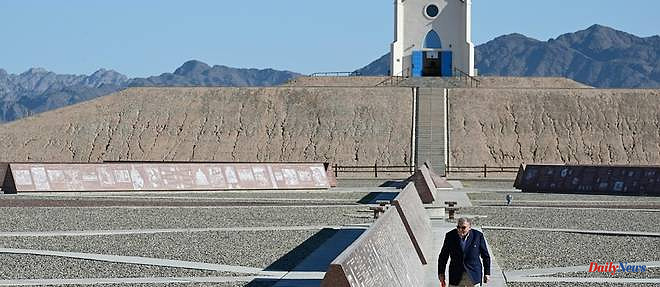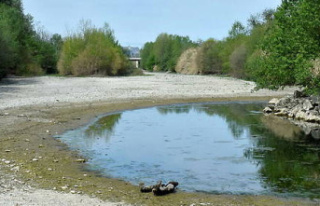Every morning under the golden dawn of the Sonoran Desert, Jacques-André Istel has breakfast in bed at Felicity. A small Californian village built on the strength of its dreams, which claims the title of "center of the world".
On a thousand hectares, the Franco-American patiently erects since 1985 an incredible universe, which claims to concentrate in one place all the history of humanity.
This open-air museum does not exist "nowhere else on this planet", insists to AFP this courteous 94-year-old man.
Here, the absurd rubs shoulders with the grandiose.
An imposing sundial, with a sculpture of the right arm of God as its needle, as represented by Michelangelo in the Sistine Chapel, serves as a clock. Not far away, an old staircase formerly installed on the Eiffel Tower climbs into the void.
At the heart of Felicity, 723 slabs of pink granite stretch out in a curious assemblage of geometric shapes. Seen from the sky, the place looks like "agrogrammes", these complex patterns carved in the fields to make believe in the existence of extraterrestrials.
Carefully engraved, the thematic stelae offer an eclectic journey through the twists and turns of humanity.
The Viking sacrificial rites thus find their place next to Alexander the Great, or the conquest of space, near other sections dedicated to hamburgers, pandas or American eating habits.
The place is framed by a chapel in the distance, and a pyramid, where a metal sign assures tourists that they are precisely at the "center of the world".
Another eccentric, the surrealist painter Salvador Dali, had already awarded this title to Perpignan station in the 1960s.
But "the center of the world can be anywhere", smiles Jacques-André Istel.
He went so far as to write to the National Geographic Institute (IGN) in 1989 to have his creation accepted. He keeps a polite letter from the French administration, acknowledging the existence of the place and its name, but which is careful not to comment on the scientific validity of the concept.
The mayor for life of Felicity does not suffer from any dispute. He won 100% of the vote, with a total of three votes: that of his wife Felicia, a Chinese-American whose name inspired the place, his own, and that of an imaginary dragon, taken from a tale for children written by him to give a legend to his village.
It is notably thanks to this book that he obtained the recognition of the local authorities, as early as 1985. Two years later, a diplomat from the Chinese consulate in San Francisco participated in the inauguration of the Felicity post office.
Because Mr. Istel has never lacked manners or interpersonal skills. This knight of the Legion of Honor still receives with elegance: blue blazer over white trousers, Ascot scarf flush under his shirt.
Born in 1929, he spent the first years of his life in Paris in a privileged home, before fleeing France during the Second World War.
His father, André Istel, an influential banker who served as a financial adviser to General Charles de Gaulle and helped create the World Bank in the post-war period, organized the family's escape to the United States.
Among the four children, Jacques-André has always been the "troublemaker". A character that quickly forged a turbulent destiny for him.
A graduate of Princeton, he made his debut on Wall Street in finance, in accordance with his father's wishes. The universe does not suit him. He enlists in the US Navy, passes his flight license and becomes fan of skydiving.
This passion will lead him to co-found the national freefall team of the United States, and will make his wealth: frustrated by the rudimentary equipment of the time, the young man perfects his sails and sets up a company which will end up selling its products to the US Army.
But why found Felicity in the middle of the desert?
"Because (...) I couldn't afford to buy San Diego," jokes Mr. Istel.
Always animated by the writing of his next plates, the dashing nonagenarian swims daily in his swimming pool.
The steles are engraved by different craftsmen and supposed to last for thousands of years. Enough to resist the seismic mood swings of California.
In the event of an earthquake, "future archaeologists will make a great discovery", he laughs.
However, this self-proclaimed "history bugger" refuses to claim posterity: over time, "everything ends up being forgotten".
05/05/2023 07:42:16 - Felicity (United States) (AFP) - © 2023 AFP












